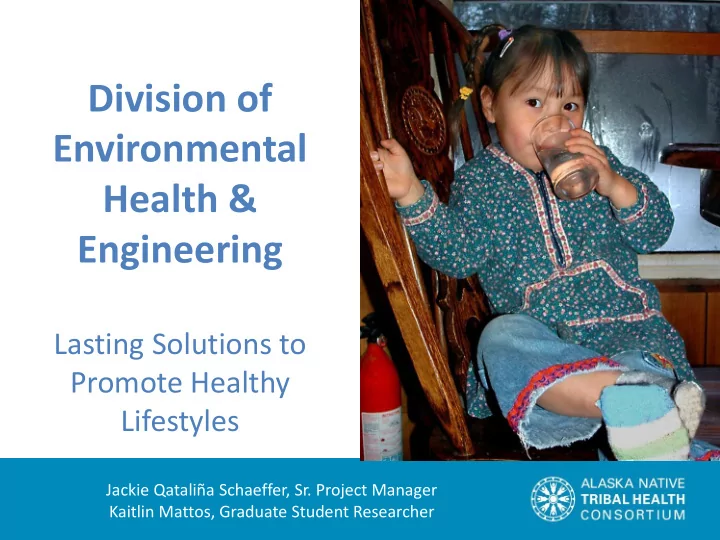

Division of Environmental Health & Engineering Lasting Solutions to Promote Healthy Lifestyles Jackie Qataliña Schaeffer, Sr. Project Manager Kaitlin Mattos, Graduate Student Researcher
Innovative Design, Research and Development Portable Alternative Sanitation System (P.A.S.S.) Why P.A.S.S.? Strategy to Eligibility Improved Sanitation Improved Quality of Life P.A.S.S. unit Flush/Haul System Piped Honey Bucket Outhouse Levels of sanitation service in rural Alaska
State of Alaska Sanitation Profile 2017 Type of Service - # of communities Piped-105 Unserved-31 6% 7% Wells/Septic-20 Mixed-13 11% Haul-11 59% 17%
Infectious Diseases and Sanitation in Rural Alaska $1.6 billion in sanitation infrastructure Study conducted by CDC and ANTHC on health impacts 7 regions and the Yukon-Kuskokwim region studied Diseases often spread by contaminated hands, coughs and sneezes
History of PASS R&D: May 2015 Launch of R&D PASS 1.0 project in Kivalina August 2015 Installations Completed in 9 homes Sep/Dec/Feb 2015/16 1/3/6-month follow-up interviews with homeowners 2016 – 2017 Design modifications completed to PASS 2.0 New seepage pit design, New toilet design June 2017 Launch of R&D PASS in Chalkyitsik, Alatna, Allakaket August 2017 Upgrade to PASS 2.0 in 2 homes in Kivalina November 2017 Installations Completed in 2 homes in Chalkyitsik January 2018 Installations Completed in 3 homes in Alatna January 2018 Installations Completed in 2 homes in Allakaket January 2018 Installation Completed in 1 home in Oscarville August 2018 Upgrades to PASS 2.0 in 6 homes in Kivalina September 2018 Installation of 2 homes in Allakaket to be completed January 2019 R&D complete, Manufacturing/Deployment Phase begins Summer 2019/20 Installation of 45 PASS 2.0 units in Kivalina Installation of units in Mertarvik
Benefits P.A.S.S. unit: 1. RAIN CATCHMENT: Sediment separator begins filtering as it captures the raw water. 2. WATER STORAGE TANK: Dual-filtration system prior to water storage changes how we think of our potable water and its storage. 3. LOW-FLOW SINK: A gravity-fed flow of water to wash hands allows for better hygiene and NO MORE WASH BASIN! 4. WATERLESS URINAL: Separating the liquid waste allows for less disposal and less odor. 5. INTEGRATED VENTILATION: An energy-efficient combined ventilation system dries the solid waste, reduces odors, and ventilates the home – creating better air circulation throughout the home. 6. SEPARATING TOILET: Waste is separated into liquid and solid components where the liquid is disposed of into a seepage pit and dried solids are disposed of in the landfill. This toilet provides the option to revert to a containerized system if the drainage system freezes in the cold winter months. NO MORE HONEY BUCKET! 7. WATER TREATMENT SYSTEM: The water treatment system incorporates cartridge filters and chlorination for point-of-use treatment to ensure the water is safe to drink despite its condition upon entering the system.
Typical System Layout: 5 1 2 4 7 1. RAIN CATCHMENT 2. WATER STORAGE TANK 3. LOW-FLOW SINK 3 6 4. WATERLESS URINAL 5.INTEGRATED VENTILATION 6. SEPARATING TOILET 7. WATER TREATMENT SYSTEM
Engineering design to work with environment: Freeze/Thaw cycle seepage pit Working WITH the environment, not against it .
Challenges: Soil conditions need to be perkable Temperature variances could freeze system drainage pit Design retrofitting to current housing infrastructure could require extensive remodels Homeowner buy-in is essential for success User education must be provided one-on-one Short-term alternative, possibly only alternative
Opportunities: Low Cost compared to piped infrastructure Stand alone system with low electrical use Portability of components Potential for homeowner add-on: circulating pump, hot water on demand, shower Potential for phased design approach while awaiting infrastructure
Supporting Infrastructure: Modular Laundromat/Washeteria Modular Water Treatment Plant Watering Point – Water Treatment Plant, School, Raw Water Source Solid Waste Disposal system Landfill
Cost for P.A.S.S. unit: Materials ONLY: Seepage Pit $600.00 Diverting Toilet $1,926.00 Ventilation $500.00 Water Treatment System & Tank $5,567.00 Rain Catchment System $500.00 Sink, Faucet, & Misc. Plumbing fittings and valves $1,000.00 $10,093.00 TOTAL Variable Costs: Archeological Remodeling Installation Logistics and transportation Design & Engineering (if needed)
Northwest Arctic: Kivalina Interior: Chalkyitsik, Allakaket, Alatna YK Delta: Oscarville, Mertarvik Kivalina Chalkyitsik Kotzebue Alatna Allakaket Fairbanks Mertarvik Oscarville Bethel Current PASS Projects
Current Projects: Northwest Arctic: Kivalina Interior: Chalkyitsik, Allakaket, Alatna YK Delta: Oscarville Seepage Pit, Chalkyitsik Elder, Allakaket Elder Home, Allakaket
Current Projects: Chalkyitsik Home Complete Install Bath remodel Elder + 3 grandkids
Current Projects: Oscarville Home Complete Install New Construction 2 Adults, 5 children Finished Kitchen Design Boards
PASS Health Impact Study Research Questions 1) How is water used inside and outside of the home? Sustainability 2) How is waste managed inside and outside of the home? Assessment 3) Have the PASS units improved overall health and well-being? 4) How have the PASS units affected household water access, sources, and uses? 5) Does the water component of the PASS units fit into existing community values, traditional knowledge, and practices? Village Year 1 Control Year 1 Year 2 Year 2 Households pre-PASS Control post-PASS Kivalina 11 22 11 22 Newtok 9 17 9 0 Mertarvik 0 0 0 17
Questions?
Quyana! Taikuu! Thank you! Alaska Native Tribal Health Consortium Division of Environmental Health and Engineering 4500 Diplomacy Drive, Suite 454 Anchorage, Alaska 99508 (907) 729-1900 Email: Jackie Qataliña Schaeffer: jdschaeffer@anthc.org
Recommend
More recommend